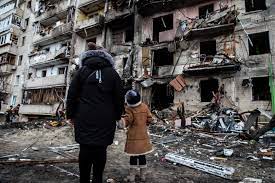Just before 10:00 PM (PST) on February 24th, Russian President Vladimir Putin appeared on state-owned television channels to announce the start of a “special military operation” within the territory of Ukraine. This incursion followed a steady increase in tensions between the two countries and a prolonged period of military buildup on the Eastern and Northern borders of Ukraine.
For several months, Western intelligence-gathering agencies, such as the American CIA and British GCHQ, disagreed over the validity of the Russian threat to Ukraine. Multiple Ukrainian officials even downplayed the possibility of an invasion in the weeks preceding February 24th. But now, the intent of the Russian government and Vladimir Putin, at least in the short term, is clear: a large-scale movement of Russian military assets into Ukrainian territory from the North, East, and South.
Ukrainians and foreign journalists reported large explosions immediately after Putin’s speech concluded, as Russian cruise missiles began to bombard critical military assets, pieces of infrastructure, and alarmingly, civilian population centers. Forty-eight minutes after the assault began, surveillance video from a Ukrainian border crossing showed Russian soldiers entering Ukraine in armored vehicles from the Crimean Peninsula in the South. During the initial chaos, American intelligence officials calculated the capital city of Kyiv would be overrun and captured in less than 96 hours.
In the following days, the Ukrainian government, led by comedian-turned-politician President Volodymyr Zelenskyy, hastily organized a defense. Martial law was declared, and all men aged 18 to 60 were barred from leaving the country. The Ukrainian army worked to hold back the Russian advance and secure important cities as the air force quickly announced the downing of several Russian fighter jets within two hours of the assault. Zelenskyy took to social media at the end of the first day of fighting. He filmed himself and several government ministers standing outside a government building in central Kyiv, saying “The head of the Presidential Office is here. The Prime Minister is here. […] The President is here. We are all here. […] Glory to our defenders, male and female. Glory to Ukraine!”
Zelenskyy’s decision to stay in the capital provided a massive morale boost to frightened Ukrainian citizens. Many immediately began to organize neighborhood watches and evacuate the sick and elderly to bomb shelters and subway platforms. Several social media accounts showed civilians collecting bottles and flammable liquids used to create “Molotov Cocktails,” an improvised weapon made by filling a bottle with gasoline and adding a wick. When ignited and thrown at a structure, the gas is dispersed, creating a deadly plume of fire and toxic smoke.
In recent weeks, the Russian forces have met stiff resistance from the Ukrainian army and civilian patrols. The progress made by Russian forces has slowed to a crawl as the fighting shifts from decisive battles to a war of attrition. Nonetheless, Zelenskyy has begged his Western allies and NATO for supplies and military support. When U.S officials advised him to evacuate his government, Zelenskyy purportedly responded, “The fight is here. I need ammunition, not a ride.”
As the crisis becomes prolonged, many are worried about the invasion’s political and humanitarian costs. “Russian or Ukrainian soldiers would decimate the food source of 44 million Ukrainian people,” said Oakland Tech Senior, Benjamin Salop, “Many nations that may have shifted from the Russian sphere of influence are now cementing alliances with Western allies. […] Putin continues to invade, using highly controversial tactics […] raising the risk of chemical, biological, or nuclear warfare.” Many Oakland Tech students have started fundraisers for foreign aid campaigns and even the Ukrainian army.
Other students focus on raising awareness of the contrast between the treatment of Ukrainian refugees and refugees from other countries. Another 12th grader, Ndina Niesar, explains: “The crisis in Ukraine is a perfect example of racial bias. When people from Central America are running from war and violence, they are shot and thrown into cages like animals. […] When Africans are running from war and violence, they face hate crimes and exploitation. When white Ukrainians are fleeing war and violence, they’re brave. […] Of course Ukrainians deserve empathy and support, but so do the millions of African and Latino refugees who are being treated like criminals.”
